
Depleted uranium (DU) is a byproduct of the uranium enrichment process used in nuclear power plants and weapons production. DU has been used in medical and industrial applications for decades but since its use in recent military conflicts public concern been raised about potential health consequences from exposure to DU.


/environment-climate-change-and-health-(ech)/radiation-and-health-(rad)/dsc05929c4955aee7bb74f19867e568303ae1d42.jpg?sfvrsn=e92215b5_2)
